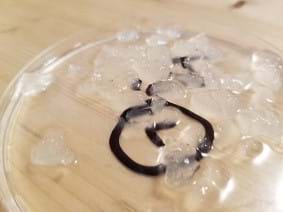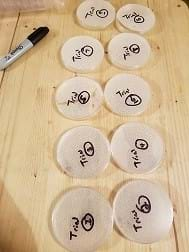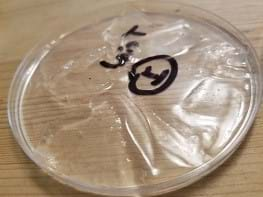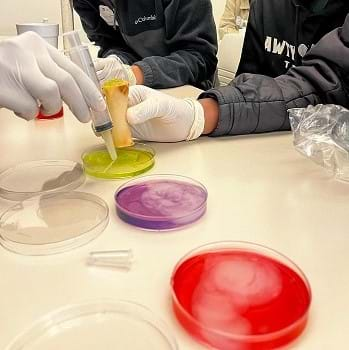Quick Look
Grade Level: 10 (9-11)
Time Required: 5 hours 30 minutes
(11 class periods, all partial, ranging from 10-30 minutes)
Expendable Cost/Group: US $2.00
Group Size: 3
Activity Dependency: None
Subject Areas: Biology, Chemistry, Earth and Space, Science and Technology
NGSS Performance Expectations:

| HS-ETS1-1 |
| HS-LS2-7 |
Summary
What can engineers do to help solve problems related to water conservation? In this activity, students design methods that concentrate on supplying plants with a steady source of water without the cost or depletion of aquifers caused by using some type of irrigation method. Students develop hydrogels that help to retain soil moisture while being biodegradable and nontoxic.
Engineering Connection
Water conservation is a world-wide area of concern. This area has a variety of engineering applications from agriculture, individual household, hospitality and recreation. This activity focuses on the agricultural application to reduce the amount of irrigation needed and mitigate the loss of water through evaporation. In addition, the hydrogels for this activity are biodegradable. There are hydrogels that are used currently in potting soils to help retain moisture, but they are not biodegradable. These types of hydrogels would not be suited to agricultural applications since they pose the risk of contaminating aquatic ecosystems.
Learning Objectives
After this activity, students should be able to:
- Describe the ways the proposed solution decreases the negative effects of human activity on the environment.
- Calculate the amount of water released and reabsorbed by the individual hydrogel formulations.
- Determine which hydrogel formula would be the best solution to retain soil moisture with appropriate reasoning.
Educational Standards
Each TeachEngineering lesson or activity is correlated to one or more K-12 science,
technology, engineering or math (STEM) educational standards.
All 100,000+ K-12 STEM standards covered in TeachEngineering are collected, maintained and packaged by the Achievement Standards Network (ASN),
a project of D2L (www.achievementstandards.org).
In the ASN, standards are hierarchically structured: first by source; e.g., by state; within source by type; e.g., science or mathematics;
within type by subtype, then by grade, etc.
Each TeachEngineering lesson or activity is correlated to one or more K-12 science, technology, engineering or math (STEM) educational standards.
All 100,000+ K-12 STEM standards covered in TeachEngineering are collected, maintained and packaged by the Achievement Standards Network (ASN), a project of D2L (www.achievementstandards.org).
In the ASN, standards are hierarchically structured: first by source; e.g., by state; within source by type; e.g., science or mathematics; within type by subtype, then by grade, etc.
NGSS: Next Generation Science Standards - Science
| NGSS Performance Expectation | ||
|---|---|---|
|
HS-ETS1-1. Analyze a major global challenge to specify qualitative and quantitative criteria and constraints for solutions that account for societal needs and wants. (Grades 9 - 12) Do you agree with this alignment? |
||
| Click to view other curriculum aligned to this Performance Expectation | ||
| This activity focuses on the following Three Dimensional Learning aspects of NGSS: | ||
| Science & Engineering Practices | Disciplinary Core Ideas | Crosscutting Concepts |
| Analyze complex real-world problems by specifying criteria and constraints for successful solutions. Alignment agreement: | Criteria and constraints also include satisfying any requirements set by society, such as taking issues of risk mitigation into account, and they should be quantified to the extent possible and stated in such a way that one can tell if a given design meets them. Alignment agreement: Humanity faces major global challenges today, such as the need for supplies of clean water and food or for energy sources that minimize pollution, which can be addressed through engineering. These global challenges also may have manifestations in local communities.Alignment agreement: | New technologies can have deep impacts on society and the environment, including some that were not anticipated. Analysis of costs and benefits is a critical aspect of decisions about technology. Alignment agreement: |
| NGSS Performance Expectation | ||
|---|---|---|
|
HS-LS2-7. Design, evaluate, and refine a solution for reducing the impacts of human activities on the environment and biodiversity. (Grades 9 - 12) Do you agree with this alignment? |
||
| Click to view other curriculum aligned to this Performance Expectation | ||
| This activity focuses on the following Three Dimensional Learning aspects of NGSS: | ||
| Science & Engineering Practices | Disciplinary Core Ideas | Crosscutting Concepts |
| Design, evaluate, and refine a solution to a complex real-world problem, based on scientific knowledge, student-generated sources of evidence, prioritized criteria, and tradeoff considerations. Alignment agreement: | Moreover, anthropogenic changes (induced by human activity) in the environment—including habitat destruction, pollution, introduction of invasive species, overexploitation, and climate change—can disrupt an ecosystem and threaten the survival of some species. Alignment agreement: Biodiversity is increased by the formation of new species (speciation) and decreased by the loss of species (extinction).Alignment agreement: Humans depend on the living world for the resources and other benefits provided by biodiversity. But human activity is also having adverse impacts on biodiversity through overpopulation, overexploitation, habitat destruction, pollution, introduction of invasive species, and climate change. Thus sustaining biodiversity so that ecosystem functioning and productivity are maintained is essential to supporting and enhancing life on Earth. Sustaining biodiversity also aids humanity by preserving landscapes of recreational or inspirational value.Alignment agreement: When evaluating solutions it is important to take into account a range of constraints including cost, safety, reliability and aesthetics and to consider social, cultural and environmental impacts.Alignment agreement: | Much of science deals with constructing explanations of how things change and how they remain stable. Alignment agreement: |
Materials List
Each group needs:
- disposable diaper
- large bowl or plastic tub
- gram scale
- petri dish or small plastic condiment cup
- sharpie
- spoon for stirring
- beaker or some other container to mix the hydrogel
- weighing boat or small plastic condiment cup
- 50 mL boiling water
- paper towels
- safety goggles (one pair per student)
- Hydrogel Lab Sheet
For the entire class to share:
- whiteboards
- whiteboard markers
- box fan, drying oven, or clamp light
- chemicals to create hydrogels (amounts are enough for 6 groups using the given combinations below):
- 8 g agar
- 8 g hydroxyethyl cellulose [HEC] reagent grade powder
- 8 g sodium carboxymethyl cellulose [CMC] powder
- 6 g citric acid
Student groups can research and create their own compound for the hydrogel, or they may use the amounts and combinations given below. The following are the amounts needed for six lab groups. If there are more than 6 lab groups, some groups can test the same combinations to compare results. This amount fits into a standard plastic petri dish.
- Combination 1
- 4 g agar
- 1 g citric acid
- 50 mL hot water
- Combination 2
- 4 g HEC
- 1 g citric acid
- 50 mL hot water
- Combination 3
- 4 g CMC
- 1 g citric acid
- 50 mL hot water
- Combination 4
- 2 g HEC
- 2 g agar
- 1 g citric acid
- 50 mL hot water
- Combination 5
- 2 g HEC
- 2 g CMC
- 1 g citric acid
- 50 mL hot water
- Combination 6
- 2 g CMC
- 2 g agar
- 1 g citric acid
- 50 mL hot water
Worksheets and Attachments
Visit [www.teachengineering.org/activities/view/uoh-2667-biodegradable-hydrogels-water-conservation] to print or download.Pre-Req Knowledge
Basic knowledge of the water cycle and the use of water by plants for photosynthesis is helpful but not essential.
Introduction/Motivation
Conservation of water is a worldwide issue that concerns everyone. Even areas that have seemingly large water reserves, such as the Great Lakes, still have areas with water shortages. There is a huge variety of ways to conserve water or protect water resources but there are also many competing entities using those resources. Clean water is needed for drinking, household use, laundry (including hotels and other commercial businesses), agriculture, recreation, and wildlife.
Today we are going to focus on conserving water used for agricultural purposes. We will be making hydrogels. Using sodium carboxymethyl cellulose (CMC), agar, and / or hydroxyethyl cellulose (HEC) powders, we will create polymers that make a network to hold the water and give it structure. A slightly acidic solution seems to promote those polymers to arrange in a way that allows the water molecules to enter or leave the structure more easily. This is the reason the citric acid powder is used.
Let’s get started!
Procedure
Background
Conservation of water is a worldwide issue that concerns everyone. Even areas that have seemingly large water reserves, such as the Great Lakes, still have areas with water shortages. There is a huge variety of ways to conserve water or protect water resources but there are also many competing entities using those resources. Clean water is needed for drinking, household use, laundry (including hotels and other commercial businesses), agriculture, recreation, and wildlife. This activity focuses on conserving water used for agricultural purposes. An extension of this activity using fertilizer built into the hydrogels can also help to reduce runoff into rivers and lakes that cause pollution.
The making of the hydrogels is simple, very similar to making Jell-O. The CMC, agar, and / or HEC powders provide the polymers that make a network to hold the water and give it structure. A slightly acidic solution seems to promote those polymers to arrange in a way that allows the water molecules to enter or leave the structure more easily. This is the reason the citric acid powder is used.
This is a good activity to explore the engineering process since there are very few needed components and there are also a variety of ways to extend the activity. Students can explore which of the polymer powders, or combination, works better. The hydrogels perform best when using a combination of two of the polymers. Furthermore, they can make hydrogels with varying amounts of polymer powder to which one reabsorbs the most water. Hydrogels that are very firm, which contain many polymers, do not reabsorb very much water. Students may even propose a new polymer to try such as gelatin. These do not work as well, but it would add more data to the engineering and scientific process.
All energy used by most organisms on earth ultimately comes from the sun and is transformed by plants through the process of photosynthesis. The glucose produced forms the basis of the food chain for a vast array of other organisms. The optimum productivity of plants is essential for providing enough food for the multitude of other organisms. The necessary reactants for photosynthesis, in addition to sunlight, are carbon dioxide and water. There is an overabundance of carbon dioxide on earth, but water is not always readily available. This activity concentrates on suppling plants with a steady source of water without the cost or depletion of aquafers caused by using some type of irrigation method. Students will develop hydrogels that help to retain soil moisture while being biodegradable and nontoxic. This activity can easily be adapted to be a short lab activity or extended into a long-term project.
The first part of the lab will determine what component(s) will dehydrate and then reabsorb the highest percentage of water. There are 3 components that are available: agar, hydroxyethyl cellulose and carboxymethyl cellulose. The citric acid is used in all combinations to make the solution acidic which helps the hydrogel polymers to build a strong network. The students can choose the combination they want to test or the teacher can assign the combinations. There are 6 prepared combinations, but you can have groups test more or do repeat testing. 
After data from the first round of testing is complete, the class will continue testing to further improvement the hydrogel product. The refinement of the hydrogel is a continuation of the engineering process. Typically, testing on a product will continue beyond the first round of tests to help improve the product or to determine if it fully meets the parameters set forth. Note, the first round of testing can be eliminated for time or money constraints, and you can go directly to the second set of experiments.
(Author note: The testing with my class found that some of the initial test combinations did not set and others set with varying ability to reabsorb water. The best combination for my class was the combination of agar and HEC together. The class then went on to test different percentages of this combination. If your class has a different combination, then you can simply substitute those polymers for the ones that are listed. However, if your class data shows that one polymer alone worked the best then I would vary the amount of the polymer using 2, 3, 4, 5, 6, and 7 grams while keeping the water and citric acid the same.)
Procedure
Day 1
- Read through the Introduction/Motivation.
- Start the activity by showing students examples of failed crops and dry soil. (For example, this article https://civileats.com/2021/06/18/small-farmers-in-california-face-tough-choices-amidst-the-drought/ or the following video: https://apnews.com/article/ap-video-436613026993)
- Give students 5 minutes to discuss in small groups the consequences and remedies for such situations of crop failure.
- Have groups share out their thoughts or present them on whiteboards.
- Students may bring up the following points or present them to the class during discussion:
- Good crop production is essential to feed all the people on earth
- Some land requires irrigation or some way to help retain water for plants to use
- Without enough water, plants will die
- Weather is unpredictable in terms of the amount and frequency of rain during a growing season
- Next, have students look at an example of a dispute of freshwater rights and use. (For example, this article: https://thecounter.org/oregon-farms-water-klamath-river-drought-salmon/ or the following video: https://www.pbs.org/newshour/show/severe-drought-reignites-decades-old-conflict-between-oregon-ranchers-indigenous-peoples)
- Have students again discuss in small groups who they believe should have the right to decide the use of the freshwater and why. (Note: Student groups may have a variety of viewpoints that are equally acceptable. Emphasize the point that no one group has the correct answer because the situation is very complex with many equally valid claims on the water, including the following points:
- Water is critical for survival, and it is in limited supply in many parts of the world.
- Water conservation is necessary to help provide as much fresh water as possible.
Day 2
- EDP Step 1 - Ask: Explain that there are many ways to conserve water, but we are going to return to our original example of the failed crops and try to engineer a solution to keep more water in the soil for longer periods of time without irrigation.
- Ask the class if they have ever seen the round, white beads in potting soil? (Either show a picture or have a sample of potting soil for the class to see.)
- Explain that these are hydrogels and give a definition to class to write in their lab notebook.
- Explain that hydrogels that they are polymers that absorb water and then can release this slowly back into the soil when conditions are drier.
- EDP Step 2 - Research: Have each student group get a diaper and a large plastic tub or bowl.
- The group should weight the diaper dry.
- Next, slowly add water to the diaper until it can no longer hold any further liquid. Do this in the plastic tub or bowl.
- Weigh the diaper again to record how much water it held.
- Students can then open the diaper, inside the plastic tub, to see and feel the hydrogels inside.
- Student groups present their data and give reasoning to explain their data.
- Return to the picture or sample of potting soil with the hydrogels. The hydrogels used in the diapers and potting soil are very similar.
- These hydrogels are made from acrylamides which can break down slowly in the soil. Acrylamide is this form is a strong neurotoxin and cancer-causing agent. The acrylamide is inhaled when it is a dust or absorbed easily through the skin.
- Students want to create a new hydrogel that can perform the same function, but without the potential health risks.
Day 3
- EDP Step 3 - Imagine
- Each lab group will produce a hydrogel using the same compounds, but in different ratios. We will then test them to determine which ratio is able to release and then reabsorb the most water. Class data will be collected from each group to include in lab report.
- Teacher should explain what the compounds are that are being used in the lab:
- Citric acid – typically comes from lemon juice
- Agar – comes from red algae
- Hydroxyethyl cellulose (HEC) – comes from a byproduct gum when the bark of spruce and pine is removed
- Sodium carboxymethyl cellulose (CMC) – comes from tree waste, banana stems and pineapple leaves
- Ask students to brainstorm which ratio of compounds they think would work best and discuss why.
- EDP Step 4 - Plan
- Have students narrow their ratio of compounds down to one choice.
- Have students develop a plan to test their ratio of compounds, including how they will determine if their compound is the best.
Day 4
- EDP Step 5 - Create a Prototype
- Distribute the Hydrogel Lab Sheet to students.
- Since the students need to now follow the lab, either
- Let students create their own compound based on their research, brainstorming, and planning OR
- Have students do the following: The following are the amounts needed for 6 lab groups. If there are more than 6 lab groups, some groups can test the same combinations to compare results. This amount fits into a standard plastic petri dish.
- Combination 1
- 4 g agar
- 1 g citric acid
- 50 mL hot water
- Combination 2
- 4 g HEC
- 1 g citric acid
- 50 mL hot water
- Combination 3
- 4 g CMC
- 1 g citric acid
- 50 mL hot water
- Combination 4
- 2 g HEC
- 2 g agar
- 1 g citric acid
- 50 mL hot water
- Combination 5
- 2 g HEC
- 2 g CMC
- 1 g citric acid
- 50 mL hot water
- Combination 6
- 2 g CMC
- 2 g agar
- 1 g citric acid
- EDP Step 6 - Initial Testing (Lab Day 1)

Initial trials of varying polymer ratios. - Ensure that students follow the instructions on the Hydrogel Lab Sheet. On Lab Day 1, they label petri dishes, weigh and add citric acid and polymer(s) to the beaker, and mix with boiling water.
- As students work, check that student teams are working together to measure and mix materials; students should be wearing goggles and being careful with the boiling water.
Day 5
- EDP Step 6 - Initial Testing (Lab Day 2)

Dried hydrogel from initial trials. - On Lab Day 2, students may use a clamp light, fan, or drying oven (on a very low setting) to ensure their hydrogels are completely dry and set (should hold firm if turned on its side).
- Ensure that students are careful with their hydrogels and that teams share the light, fan, or oven.
Day 6
- EDP Step 6 - Initial Testing (Lab Day 3)

Initial trial hydrogel that was rehydrated after drying and cutting. - On Lab Day 3, students begin collecting data before adding water.
- Check that groups are working together to record data in the data table in the Hydrogel Lab Sheet. Make sure that students clean up any spills as they add water to their petri dishes.
Day 7
- EDP Step 6 - Initial Testing (Lab Day 4)
- On Lab Day 4, students record data on water reabsorption in their Hydrogel Lab Sheet.
- As appropriate, have students discuss in their teams and as a class the importance of having a hydrogel that can absorb a lot of water. Students should mention water conservation.
Days 8-11
- EDP Step 6 - Second Round of Testing (Lab Days 5-8)
- On the remaining Lab Days, students repeat the procedure from Lab Days 1-4 using different ratios of the chosen polymer(s).
- Check that students record their data in the table in the Hydrogel Lab Sheet.
Vocabulary/Definitions
hydrogel: A cross-linked polymer that does not dissolve in water. They are highly absorbent yet maintain well defined structures.
Assessment
Pre-Activity Assessment
Whole-class Discussion: The pre-activity assessment is the content of the discussion during the engage portion of the activity. Students should be able to describe ways the proposed solution decreases the negative effects of human activity on the environment.
Activity Embedded (Formative) Assessment
Presentation of Data: The formative assessment for this activity is the presentation of data, claim, evidence and reasoning on whiteboards during a whole class discussion.
Post-Activity (Summative) Assessment
Lab Report: The summative assessment is the written lab report. See the Lab Notebook Rubric which can be used for grading.
Safety Issues
Safety Measures:
- Students should wear goggles.
- Caution with the boiling water to prevent burns.
- All materials can be disposed of down the drain or in the trash.
Activity Extensions
- Use the most absorbent hydrogel in soil samples to test how much water is retained in the soil.
- Use the most absorbent hydrogel in soil with plants also added and restrict the amount of water given to test if the hydrogels continue to provide water to the plants for a longer period of time versus no hydrogels.
- Add urea to the hydrogel formula and then do soil testing to find the rate at which the hydrogels release the nitrogen fertilizer into the soil.
- Add urea to the hydrogel formula with plants and record plant growth to see if the nitrogen released from the hydrogel is taken up by the plants.
- You can also test runoff from the soil to see how much nitrogen is being lost compared to regular fertilizers.
Activity Scaling
To make activity less challenging or time consuming, you can skip the initial testing of the various polymers and go directly to the second step of testing just the agar and HEC polymer combinations.
Subscribe
Get the inside scoop on all things TeachEngineering such as new site features, curriculum updates, video releases, and more by signing up for our newsletter!More Curriculum Like This

Students use sodium alginate to create hydrogels that have cross-linking ability, biocompatibility, chelating ability, water solubility, and low cost. These alginate-based hydrogels are also nontoxic and non-inflammatory. All these properties make the alginates ideal for applications in pharmaceutic...
Copyright
© 2023 by Regents of the University of Colorado; original © 2022 University of HoustonContributors
Christy MillerSupporting Program
RET in Advanced Design and Manufacturing, University of HoustonAcknowledgements
This curriculum was developed under National Science Foundation RET grant no. 1855147— Research Experience for Teachers in Advanced Design and Manufacturing at the University of Houston. Any opinions, findings and conclusions or recommendations expressed in this material are those of the authors and do not necessarily reflect the views of the National Science Foundation.
Last modified: October 29, 2024






User Comments & Tips